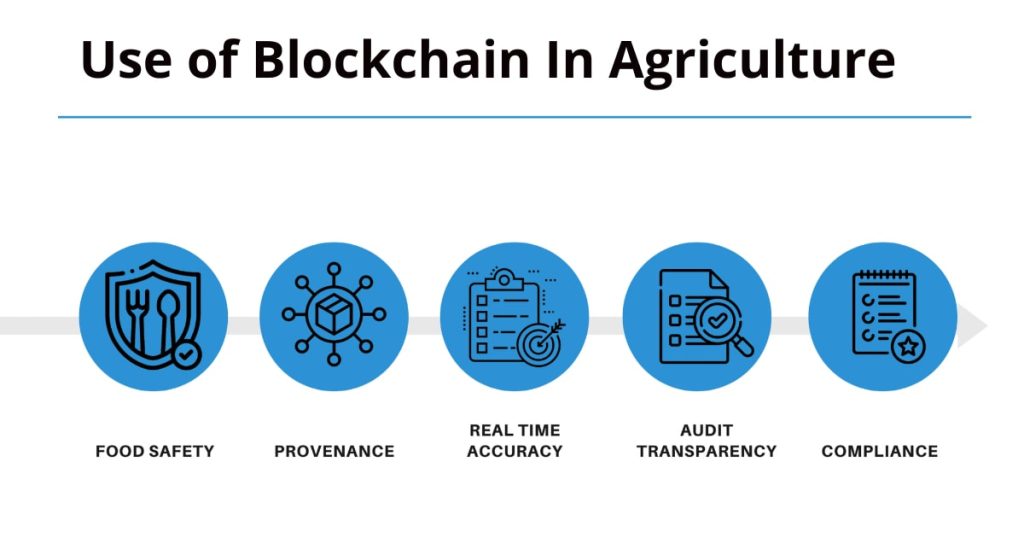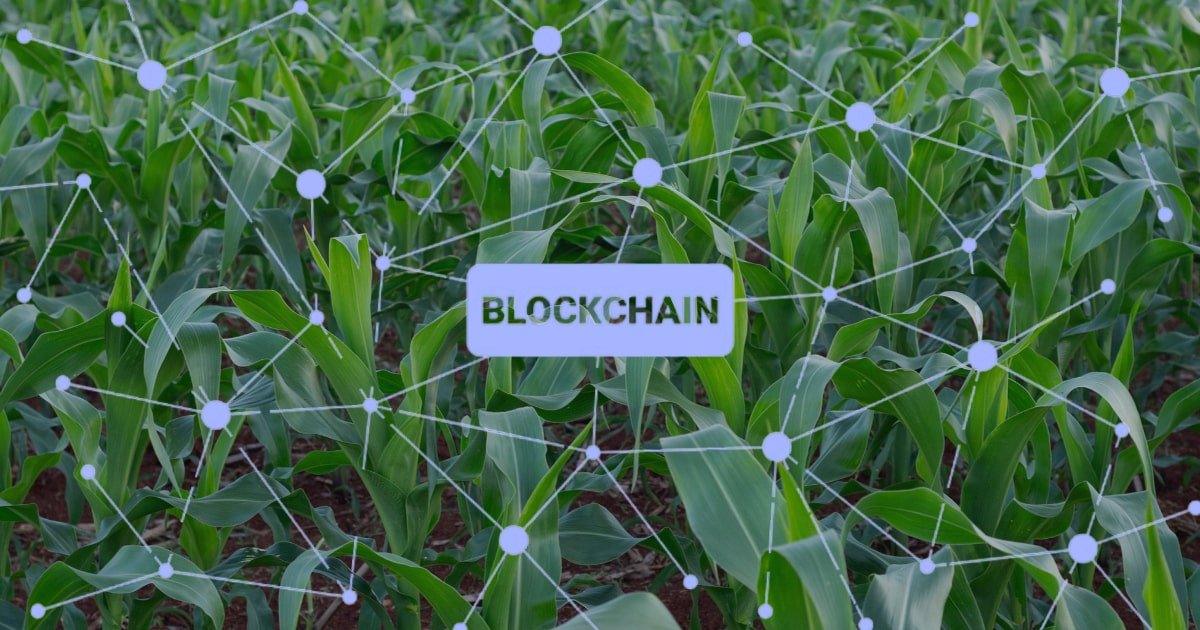Agriculture Food systems are under tremendous pressure today, with the world clocking a 9.7 billion population by 2050 with a need for a 98 % increase in food production. The farm-to-fork food supply chains face socioeconomic and environmental challenges, to overcome this challenge we have to take use technology like blockchain In agriculture.
Agriculture in numbers
Food is necessary to survive, and agriculture provides food to sustain life. Centuries ago, agricultural food was only used for consumption. Over the years, catering needs to various industries, products, trade, employment, development, environment, and revenue have taken a different dimension.
Today, approximately five billion hectares, or 38% of the world’s land surface, is used for agriculture. India positions itself as the leading country in net cropped area and second in global agriculture exports, behind the US and China.
India exports agricultural products and processed food to more than 120 other nations. This is because India has 51% cultivable land, 46 soil types, and 20 agro-climate regions.
Even with such high trade volumes and diversity, we still need help with food security, waste, and inefficiency. In the supply chain, up to 45% of the food produced is spoiled, and only 7% of perishable items are processed. Agriculture is also under tremendous pressure due to climatic changes.
Agri-food supply chains contribute to 26 % of GHG emissions. The integrity of these supply chains is also in question, with food fraud resulting in damages up to USD 40 billion annually.
Challenges in agriculture value chains
Scarcity of resources
Around the world, land, water, and issues have been scarce with soil health. These have reduced farm productivity and efficiency, creating a new breed of climate and sustainability issues.
Communication gap:
The status of farmers and businesses in the supply chain could be better and more communication. This significantly impacts ineffective management, excessive waste, and inefficiencies.
Lack of traceability:
Participants need to be made aware of what, when, and how their peers are doing, which contributes to mistrust in the supply chain. Some food chains still need to figure out how to trace products as they move through the supply chain. This leads to food contamination, waste, and fraud issues.
Inadequate support:
To improve the supply chain as a whole, the government must take action by establishing a regulatory body and providing predetermined standards, incentives, and technological know-how along with financial support. There needs to be more collaboration among the various stakeholders in the food supply chain.
Traceability in agriculture
The ability to track every aspect of a product’s development at every stage is known as traceability. The consumer and the manufacturer today want the utmost quality in their products. Consumers have a right to know where their products come from, where organic raw materials were sourced from, how sustainable the production methods and the fair share to the growers. There is a need for transparency and traceability to ensure the quality and safety of the product.
Supply chain management, traceability, and communication are essential to achieve this level of safety. If a product becomes contaminated across the supply chain, it should be simple to recall that product. Traceability serves as a tool to achieve these advantages.
Two types of contamination can occur in the food supply chain:
Internal reasons like fraud and misrepresentation, substitution, dilution, adulteration, etc.
External variables like changes in weather, temperature, seasonal items, improper transit management, etc.
Tracking and traceability thus aid in reducing such problems. A product’s capacity to be accurately identified and traced back to its source assures that it is safe and high-quality. It enables real-time detection of any contamination or staleness in the process. Ultimately, customers benefit from authentic, trustworthy, and quality brands.
The information that can be used to verify the source or origin of the data collected can be differentiated into breadth (number of data gathered), depth (amount of product tracking up or down the supply chain), and precision (amount of information accuracy), these are factors that distinguish different traceability solutions. Food traceability software helps to track food products in real-time showcasing end-to-end transparency and safety of food.
Use of Blockchain In Agriculture

Overall, the use of blockchain in agriculture has the potential to improve food safety, increase efficiency, and reduce fraud in the agricultural industry. lets check important Blockchain Features one by one
Digitalized ledger:
Data is electronically recorded, allowing faster transfers, less work, and hassle-free sharing.
Decentralized system:
It has a distributed ledger system that allows players to record and share data in cryptographically linked blocks that act as a verifiable database. This provides for a secure spread of data with numerous blocks and no single point for failure.
Immutability:
With a decentralized system, there is no third-party involvement in managing the database. Blockchain data is only entered into the system when most players feel it’s valid. This also works the other way around; no player can edit, delete or update data without the permission of the majority.
Transparency:
A vital characteristic of the blockchain is its capacity to present data to all participants in the supply chain. When data is entered and made public, a world of advantages, such as safety, trust, improved planning, decision-making, etc., becomes possible.
Traceability:
Data under Blockchain is recorded in real-time at every step of the process. It also links its approach to the upstream and downstream of its operation, making it easier to monitor a product. These are used in cases of a product recall.
All participants in the supply chain can examine the data recorded at specific points in the chain using the ledger management system known as a blockchain. It is a decentralized system.
Hence, no single authority is in charge of managing the data, and all players will be made aware of any modifications or tampering with the data. Since its adoption in the agriculture sector, there has been transparency among the supply chain participants building trust.
The capacity of Blockchain technology to track a product as it moves through the supply chain is one of its essential characteristics. With the use of many technologically advanced software and hardware tools, such as barcodes/ QR codes, RFID, wireless sensor networks, DNA bar-coding, and tracing through blockchain,
This tool ensures food safety, product quality, and authenticity. Every stage of the supply chain can now enter unchangeable data thanks to blockchain technology. Reliable data on farm products, sustainably managed meat, and organic information can be kept on file, assuring transparency and fostering consumer trust.
In addition to helping with supply chain management, blockchain also improves producers’ and processors’ internal management and productivity. Because of this, facts about the product type are tracked, including its species, quality attributes, proximate analysis, weight, volume, and variety.
Data about the various procedures involved and their specifics, such as buying, delivering, storage, harvesting, fermenting, time, and energy utilized, are recorded.
Blockchain traceability software solutions ensure end-to-end traceability with a digital identity for every product. The real-time data capture on this collaborative platform builds trust and transparency in food supply chains.
Overall, the use of blockchain in agriculture has the potential to improve food safety, increase efficiency, and reduce fraud in the agricultural industry.
How Blockchain benefits each player in the agriculture supply chain
Let us now implement Blockchain’s features into different agriculture players along with some analogies to the food supply chain.
Producer/ Farmer
- Blockchain provides visibility of processors and consumers along the supply chain, which the conventional system lacked.
- Raw material sourcing data is recorded along with production and logistics in real time.
- The origin of products can be determined to provide certification of safe, sustainable, and ethical agricultural production.
- Less transaction cost, access to insurance, and finance, better price, and faster payments.
Processor
- Products are linked to their source through every value addition made during this stage.
- Inspections and certificates are provided to the respective lots/products.
- It is at this stage that a product gets packed, stored, and sent to wear houses of distributors. All such data is shared in real-time.
Distributor
- Tracking and sharing data regarding characteristics and storage conditions of the final agri-food product are done.
- This takes place real-time for the retailer to plan and decide in advance.
- Improves trust and partnership between players.
Retailer and Consumer
- Helps retailers with better planning and tracing of products.
- Demand for ethical and sustainably sourced products can be sold at a premium.
- Quality and safety can be proved if required.
All such processes in the supply chain are interconnected to one smooth-flowing path, which at any stage can be visible and can be traced in real-time if there comes a contingency.
Conclusion
Comparing the use of Blockchain in agriculture to the centuries-long evolution of agriculture, it is clear that Blockchain technology is the quantum leap. Agricultural operations are now more straightforward because of technological developments in hardware and software. Farming decisions are more effective and efficient thanks to data analytics and analysis technologies.



